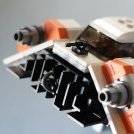
[MOC] [WIP] The Command of the AT-AT
By
LiLmeFromDaFuture, in LEGO Star Wars
-
Recently Browsing 0 members
No registered users viewing this page.

By
LiLmeFromDaFuture, in LEGO Star Wars
No registered users viewing this page.